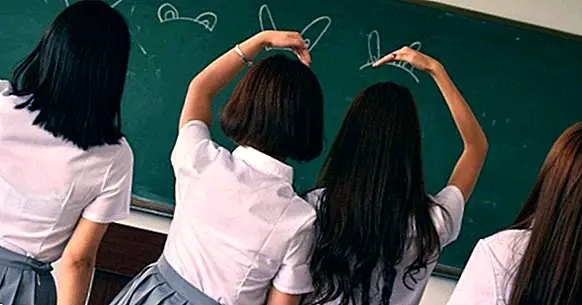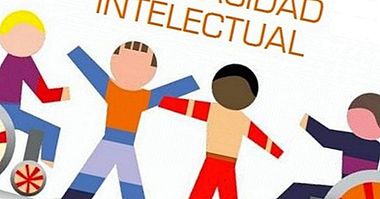Separate education by sexes: characteristics and criticisms
Throughout history, we have been able to see how different aspects related to living in society have evolved in different directions. Values, concepts, cultures, ways of seeing the world, philosophies or political systems have been born, modified and altered. The way to educate is not an exception, usually moving towards an egalitarian educational practice that seeks that everyone has the same opportunities regardless of race, condition, age or sex.
With regard to the latter, currently in most schools and educational institutions of our country children receive quality education in centers where they are trained in mixed classrooms where there is presence of both sexes, we are talking of public or private institutions. But nevertheless, still survive some schools that advocate separate education by sex . In this article, we are going to analyze what this type of education is, that it defends and the existing positions on this matter.
- Related article: "Educational psychology: definition, concepts and theories"
Separate education by sexes: what is it and what does it intend?
We call separate education by sexes, also called differentiated education or segregated education, a type of educational model which is characterized by the defense of the delivery of a separate formation of the members of each sex . In other words, we are dealing with a model that implies that children are educated with boys and girls with girls, without mixing in the classroom.
Formal education separated by gender is not a recent educational model, but appears from the moment that schooling begins to be mandatory for both sexes. Already before compulsory schooling there was a differentiated education, being in the female case focused on acquiring culture and skills necessary to successfully perform domestic chores. It would not be until 1783 that compulsory schooling of girls would start in Spain, although with a differentiated curriculum focused on traditional gender roles.
This differentiation would be maintained through the various laws that were emerging over time, forming male and female schools. In fact, mixed education did not appear in our country until 1901, although differences continued to exist and education would mostly be kept separate by sex. Also the various historical events and dictatorships would suppose a series of advances and setbacks in the search for mixed education . In fact, until the General Education Law of 1970, curricular equality and the real mixed school would not be recognized.
Today, most of the West has left behind this model, using an educational model in which mixed education of boys and girls prevails. However, there are still different schools that keep education separate by sex. Although in many cases we have a paradigm that is followed in more traditional and religious schools, the truth is that sectors have also appeared that defend it from a perspective that claims to seek the highest level of development of both sexes.
Next we will see some of the points of view taken into account both for the positions in favor of this type of model and those who are against .
- Maybe you're interested: "Sexual division of labor: what it is, and explanatory theories"
Stances in favor of this type of education
Those who defend gender-segregated education, which tend to call it differentiated education, propose that this type of education provides more educational opportunities and they are supported by the fact that it supposes an educational model to which parents who wish to do so can ascribe .
Another point that is often added is the conception that with a separate education, it is possible to make a differentiated assessment and action on specific problems of each sex and attend to the different rhythm of development presented by children. This could also facilitate that when adapting specific development rhythms education would be more adjusted and generate less abandonment and school failure and facilitating academic success by adapting education to the evolutionary particularities of each sex.
They propose that each sex sees its development rhythm accepted and validated, so that it is not constrained by the perception of differences with the other sex. Likewise, they also mention this type of education not as something sexist that pretends the submission of women to men but as a way to emancipate them.
It also tends to be considered that in mixed education a rhythm and way of acting specifically towards all students is required, without attending to the differences not only of development but of way of behaving . It is considered that the child tends to be more energetic, competitive and moved while the girl tends to a higher level of discipline and verbal and emotional reasoning.
From this position it is also believed that it is common for many girls to feel uneasy because of the high level of agitation and activity of boys, while children usually see that the level of biological maturation of their partners is greater than their own and also it penalizes their level of activation.
It has also been observed that in differentiated education there tends to be a lower level of eating disorders and problems of body self-image, in addition to lower levels of distraction on the part of both sexes.
Stances contrary to gender segregation
The opposing positions to the separated education by sexes, that they usually call it segregated education , they maintain on the other hand that the separation of both sexes in different classrooms makes it difficult to adapt to the real world. In fact, in the day to day students live and work with people of both sexes continuously, being the segregation of sexes in the school environment something that makes it difficult for them to be accustomed to working together.
Likewise, coeducation or mixed education supposes the existence of equal opportunities between both sexes, being educated in the same way and with the same options. Segregated education implies limiting these options and generating two different classes of students, not benefiting all students of the same education.
The validation of the possible differentiated levels of development can mean mistakenly assigning a lower capacity of one or the other in certain types of studies or apprenticeships. There is a risk of stereotyping students , and also not to take into account individual differences within the same genre.
They also take into account that many of the differences classically attributed to sex differences actually start in differentiated ways of educating or considering the figure of men and women, and that the biological differences that do exist and seem to make it easier for some skills to be easier to acquire and / or dominate by a certain sex are not greater than those existing among the members of the same. With regard to individual differences, from mixed education should take into account the particularities and specific needs of each student without considering that they are due solely to the biological sex with which they were born.
In addition, there would also be a positive effect at the level of values. The fact of being educated together implies that children can develop attitudes such as the acceptance of different perspectives and ways of doing things, promotes tolerance and facilitates the existence of respect and equality between men and women.
The actual situation
As we have seen, gender-segregated education is a controversial educational model that has its defenders and detractors. In Spain, recently the Constitutional Court has determined that this educational model is constitutional and that can be paid at public level , offered to those families who wish to do so. This is not an isolated case: in different European countries (for example, the United Kingdom and France) and in the American continent (in Canada and the United States) this educational model is applied in different centers of ownership that are not necessarily private. The same happens in Africa, South America, Asia and Australia.
However, at present, this type of education continues to be rejected by a large part of the population and Western society considering a model based on traditional gender roles, which generates inequalities and differences between sexes, which is not very adaptive, little representative of the real world and in which the lack of understanding and acceptance of differences and tolerance to diversity is facilitated.
Bibliographic references:
- Alcázar, J.A. and Martos, J.L. (2005). Some reflections on differentiated education by sexes. Navarra: Eunsa Astrolabio.
- Of the Order, M. (2017). Analysis of differentiated education in a context of egalitarian educational policies. Faculty of Philosophy and Letters. Cadiz University.
- Calvo, M. (2005). Children with children, girls with girls. Córdoba: Almuzara.
- Subirats, M. (2010). Coeducation or segregated school? An old and persistent debate. Journal of the Association of Sociology of Education 3 (1): 146.



















